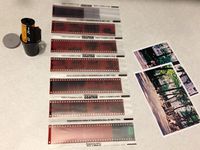Photographic paper
Dan Tobias (Talk | contribs) |
Dan Tobias (Talk | contribs) |
||
| Line 7: | Line 7: | ||
'''Photographic paper''' is different from regular [[paper]] in that it has special chemicals in it that react to light when a [[photographic film]] negative is projected on it in a darkroom, causing the picture to appear on it and then be "fixed" by use of other chemicals that make the image permanent and remove light sensitivity that would destroy it once the paper is exposed to normal lighting. | '''Photographic paper''' is different from regular [[paper]] in that it has special chemicals in it that react to light when a [[photographic film]] negative is projected on it in a darkroom, causing the picture to appear on it and then be "fixed" by use of other chemicals that make the image permanent and remove light sensitivity that would destroy it once the paper is exposed to normal lighting. | ||
| + | |||
| + | Black-and-white photographic paper was developed first (along with black-and-white film), where the exposure is a simple matter of light passing through the clear spots of the negative, getting blocked by the dark spots, and being partially absorbed by intermediate spots that are partially darkened, thus leading to the dark spots on the negative corresponding to light spots on the paper where the white background remains without dark spots being added by chemicals being exposed to light. These in turn correspond to light spots in the original thing being photographed, where the light reflecting from them exposed the film. | ||
| + | |||
| + | Color photography is more complicated, with different layers of the negative sensitive to different colors, producing a multicolored image in the film which is then projected on the paper to trigger different chemicals that produce colors matching the originals, and requiring a more complex development process. | ||
* [[Stereocard]] | * [[Stereocard]] | ||
Revision as of 20:23, 21 September 2013
Photographic paper is different from regular paper in that it has special chemicals in it that react to light when a photographic film negative is projected on it in a darkroom, causing the picture to appear on it and then be "fixed" by use of other chemicals that make the image permanent and remove light sensitivity that would destroy it once the paper is exposed to normal lighting.
Black-and-white photographic paper was developed first (along with black-and-white film), where the exposure is a simple matter of light passing through the clear spots of the negative, getting blocked by the dark spots, and being partially absorbed by intermediate spots that are partially darkened, thus leading to the dark spots on the negative corresponding to light spots on the paper where the white background remains without dark spots being added by chemicals being exposed to light. These in turn correspond to light spots in the original thing being photographed, where the light reflecting from them exposed the film.
Color photography is more complicated, with different layers of the negative sensitive to different colors, producing a multicolored image in the film which is then projected on the paper to trigger different chemicals that produce colors matching the originals, and requiring a more complex development process.
